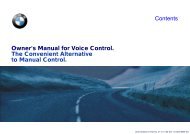Owner's Manual for the vehicle. With a quick reference ... - E38.org
Owner's Manual for the vehicle. With a quick reference ... - E38.org
Owner's Manual for the vehicle. With a quick reference ... - E38.org
Create successful ePaper yourself
Turn your PDF publications into a flip-book with our unique Google optimized e-Paper software.
146nCoolant<br />
Do not add coolant to <strong>the</strong> cooling<br />
system when <strong>the</strong> engine is hot.<br />
Escaping coolant can cause burns.<br />
To avoid <strong>the</strong> possibility of damage later<br />
on, never use anything o<strong>the</strong>r than factory-approved,<br />
nitrite and amino-free<br />
extended-duty antifreeze with corrosion<br />
protectant. Your authorized BMW center<br />
is familiar with <strong>the</strong> official specifications.<br />
Antifreeze and anti-corrosion agents<br />
are hazardous to health. Store antifreeze<br />
and anti-corrosion agents in <strong>the</strong>ir<br />
original containers where <strong>the</strong>y are inaccessible<br />
to children.<br />
Extended-duty antifreeze with corrosion<br />
inhibitor contains ethylene glycol - a<br />
flammable substance. For this reason,<br />
do not spill antifreeze with corrosion inhibitor<br />
on hot engine components. It<br />
could catch fire and cause serious<br />
burns.<<br />
380de081<br />
Correct coolant level when <strong>the</strong> engine<br />
is cold (approx. 687/206):<br />
Unscrew <strong>the</strong> cap from <strong>the</strong> expansion<br />
tank.<br />
The coolant level is correct when <strong>the</strong><br />
end of <strong>the</strong> red float is aligned with <strong>the</strong><br />
upper edge of <strong>the</strong> filler opening (refer to<br />
<strong>the</strong> arrow in <strong>the</strong> illustration or <strong>the</strong> schematic<br />
diagram next to <strong>the</strong> cap).<br />
The coolant is a mixture of water and<br />
extended-duty antifreeze with corrosion<br />
inhibitor. Always maintain <strong>the</strong> prescribed<br />
all-season 50:50 mixture ratio<br />
<strong>for</strong> year-round protection against internal<br />
corrosion. No o<strong>the</strong>r additives are required.<br />
Replace <strong>the</strong> coolant every four years.<br />
To add coolant<br />
Wait until <strong>the</strong> engine cools be<strong>for</strong>e removing<br />
<strong>the</strong> cap from <strong>the</strong> expansion<br />
tank. The needle of <strong>the</strong> coolant temperature<br />
gauge in <strong>the</strong> instrument cluster<br />
must be located in <strong>the</strong> blue zone; o<strong>the</strong>rwise,<br />
<strong>the</strong>re is a danger of scalding.<br />
1 Start by turning <strong>the</strong> cap counterclockwise.<br />
Pause to allow any accumulated<br />
pressure to escape, <strong>the</strong>n remove<br />
<strong>the</strong> cap<br />
2 If <strong>the</strong> coolant is low, slowly add coolant<br />
until <strong>the</strong> correct level is reached –<br />
do not overfill.<br />
Comply with <strong>the</strong> applicable environmental<br />
laws regulating <strong>the</strong> disposal<br />
of extended-duty antifreeze with<br />
corrosion inhibitor.



